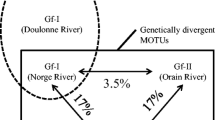Abstract
Recent studies on morphology and genetics of marinerotifer populations have demonstrated the existence ofconsiderable variation. Differences in theglycoprotein structure of a mate recognition pheromone(MRP) probably have a primary role in maintainingspecies boundaries among Brachionus species.This study examined factors involved in mating toclarify their relation with genetic variability. Threeexperiments were performed using 3 Brachionusplicatilis strains (Russia, Germany and Tokyo) and 4B. rotundiformis strains (Hamana, Fiji, Thai andSpain).Selfing and cross mating of 7 rotifer strains wasconducted in the first experiment. Russian malesmated with B. plicatilis females in thefollowing increasing order, based on mating attempts:German, Tokyo and Russia. There was little matingattempts with females of B. rotundiformisstrains. In a second set of experiments, the binding of anantibody (anti-MRP) derived from the MRP of Russianstrain was tested. A fluorescent label was attached toanti-MRP and the antibody reacted with the MRP onfemales of seven strains. The fluorescence intensity,indicating the degree of antibody binding, wasmeasured with epifluorescence microscopy and imageanalysis. The binding intensity of the anti-MRP to theMRP was in the following increasing order: Hamana,Fiji, Spain, German, Tokyo, Thai and Russia.It was expected that when the anti-MRP binds tothe MRP of a female, the male‘s recognition of thefemale would be inhibited. In the third experiment,male mating with females exposed to the anti-MRP wascompared with unexposed females. Russia Tokyo, Thaiand Spain females exposed to anti-MRP, elicited fewermale mating attempts than unexposed females. Matingfrequency and anti-MRP binding significantlycorrelated with genetic distance obtained from isozymeanalysis.
Similar content being viewed by others
References
Fu, Y., K. Hirayama & Y. Natsukari, 1991a. Morphological differences between two types of the rotifer Brachionus plicatilis O. F. Müller. J. exp. mar. Biol. Ecol. 151: 29–41.
Fu, Y., K. Hirayama & Y. Natsukari, 1991b. Genetic divergence between S and L type strains of the rotifer Brachionus plicatilis O. F. Müller. J. exp. mar. Biol. Ecol. 151: 43–56.
Fu, Y., A. Hagiwara & K. Hirayama, 1993. Crossing between seven strains of the rotifer Brachionus plicatilis. Nippon Suisan Gakkaishi 59: 2009–2016.
Gómez, A. & M. Serra, 1995. Behavioral reproductive isolation among sympatric strains of Brachionus plicatilisMüller 1786: insights into the status of this taxonomic species. Hydrobiologia 313/314: 111–119.
Hagiwara, A. & K. Hirayama, 1993. Preservation of rotifers and its application in the finish hatchery. In Lee, C. S., M. S. Su & I. C. Liao (eds), Finfish Hatchery in Asia: Proc. Finish Hatchery in Asia ’91. Tungkang Marine Lab., Taiwan Fisheries Research Inst., Tungkang, Taiwan. Pitung, TML Conf. Proc. 3: 61–71.
Hagiwara, A., T. Kotani, T.W. Snell, M. Assava-Aree & K. Hirayama, 1995. Morphology, genetics, and mating behavior of small tropical marine Brachionusstrains (Rorifera). J. exp. mar. Biol. Ecol. 194: 25–37.
Hirayama, K. & I. F. M. Rumengan, 1993. The fecundity patterns of S and L type rotifers of Brachionus plicatilis. Hydrobiologia 255/256: 153–157.
Rico-Martínez, R. & T. W. Snell, 1995a. Male discrimination of female Brachionus plicatilisMüller and Brachionus rotundiformis Tschugunoff (Rotifera). J. exp. mar. Biol. Ecol. 190: 39–49.
Rico-Martínez, R. & T. W. Snell, 1995b. Mating behavior and mate recognition pheromone blocking ofmale receptors in Brachionus plicatilisMüller (Rotifera) strains. Hydrobiologia 313/314: 105–110.
Rico-Martínez, R. & T. W. Snell, 1997. Comparative binding of antibody to a mate recognition pheromone on female Brachionus plicatilisand Brachionus rotundiformis. (Rotifera). Hydrobiologia 358: 71–76.
Rogers, J. S., 1972. Studies in genetics VII. University of Texas, University of Texas Publication, No. 7213, Austin, Texas, 145 pp.
Rumengan, I. F. M., H. Kayano & K. Hirayama, 1991. Karyotypes of S and L type rotifers Brachionus plicatilisO. F.Müller. J. exp. mar. Biol. Ecol. 154: 171–176.
Segers, H., 1995. Nomenclature consequences of some recent studies on Brachionus plicatilis(Rotifera, Brachionidae). Hydrobiologia 313/314: 121–122.
Snell, T. W., 1989. Systematics, reproductive isolation and species boundaries inmonogonont rotifers. Hydrobiologia 186/187: 299–310.
Snell, T. W. & C. A. Hawkinson, 1983. Behavioral reproductive isolation among populations of the rotifer Brachionus plicatilis. Evolution. 37: 1294–1305.
Snell, T. W. & F. H. Hoff, 1987. Fertilization and male fertility in the rotifer Brachionus plicatilis. Hydrobiologia 147: 329–334.
Snell, T. W., P. D. Morris & G. Cecchine, 1993. Localization of the mate-recognition pheromone in Brachionus plicatilisO. F.Müller (Rotifera) by fluorescent labeling with lectins. J. exp. mar. Biol. Ecol. 165: 225–235.
Snell, T. W., R. Rico-Martínez, L. S. Kelly & T. E. Battle, 1995. Identification of a sex pheromone from a rotifer. Mar. Biol. 123: 347–353.
Author information
Authors and Affiliations
Rights and permissions
About this article
Cite this article
Kotani, T., Hagiwara, A. & Snell, T.W. Genetic variation among marine Brachionus strains and function of mate recognition pheromone (MRP). Hydrobiologia 358, 105–112 (1997). https://doi.org/10.1023/A:1003176221840
Issue Date:
DOI: https://doi.org/10.1023/A:1003176221840




